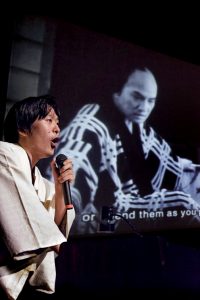The advent of cinema in the late 19th century was a force of art and technology that left no corner of the globe untouched. Japan was no exception. In fact, the rise of film as a native art form in the country happened to coincide with its modernization and subsequent rise on the global stage. Already by the 1920s, Japan would become one of the major film producers in the world, sometimes adapting foreign ideas – the westerns that once were ubiquitous in American cinema had a parallel in the Japanese “jidaigeki” (literally “period drama”), other times inventing traditions of their own.
Among the latter were “benshi,” performers who narrated silent film screenings in Japan. But “narrator” didn’t quite describe the scope of what benshi did because they also could voice the characters and impart their own perspective on the film’s narrative. Some benshi would become famous in their own right.
But with the emergence of talkies in the early 1930s, the benshi tradition dwindled.
Fast-forward some 80 years later and a resurgence of interest in benshi has taken hold in Japan as well as among foreign film connoisseurs. Among the most celebrated of this new generation of benshi is Ichirō Kataoka. He’ll be displaying his craft at a screening of Buntarō Futagawa’s 1925 film “Orocho” on Friday, April 14 at the Hammer Museum’s Billy Wilder Theatre.
In anticipation of the performance, Kataoka agreed to an interview with the Crescenta Valley Weekly through his interpreter, Kyoko Omori.
Crescenta Valley Weekly: Please tell me a little bit about how you found out about the art of the benshi and what motivated you to pursue this art yourself.
Ichirō Kataoka: I belonged to the theater club at high school and was interested in acting. Because my great uncle was a benshi during the silent film era, I knew about the occupation. But I thought it was a performing art of the past. However, among various stages that I went to see around that time, I met Midori Sawato, the leading contemporary benshi today, and chose to become her disciple.
CV: Japanese silent films on DVD or Blu-Ray tend to not include any benshi contribution. Would you say that a vital component in these films is lost? Were Japanese silent films built around the expectation that a benshi would be present?
IK: It is difficult to enjoy the art of benshi when it is only through recording. They don’t let you feel the atmosphere of the screening with much presence. If you want to make a DVD that lets the audience enjoy the benshi’s art, you should be willing to record live performances at screenings in theaters over and over, and to decide on the best take from among those recordings. In the silent film era, filmmakers in Japan were conscious of the fact that benshi performers would be present when their movies were exhibited. However, not all directors appreciated this. The more skilled of them were, in fact, bitter about benshi adding unnecessary words to their films. On the other hand, filmmakers who were making cheap and quick movies seemed to have thought that a benshi could make any movies coherent.
CV: For the screening of “Orochi,” a modern score has been commissioned. But in the 1920s, what sort of music was usually employed in the theatre? Were scores improvised? Or were the films accompanied by popular songs of the era?
IK: Japanese movie theaters were broadly divided into two categories. One type specialized in Japanese movies; the others specialized in Western movies. As many early Japanese movies were films of kabuki stage performances, theatre bands at the time played adaptations of kabuki music. For foreign movies, theaters mainly played selections from Western classical music. However, as Japanese movies gradually developed and acquired their own expressions, bands at movie theaters were composed of a combination of Japanese and Western musical instruments. They also began writing original songs for Japanese films. “Orochi,” the movie we are showing this week, is one of those movies that was produced right during transitional era. Japanese movie theaters bands rarely improvised,
CV: A benshi is often described as a kind of narrator, but his work went beyond that. Please explain what else he was expected to do.
IK: The job of a benshi involves various aspects of performing arts such as watching films, writing scripts and listening to music. I find benshi as a very rich performing art. However, what was expected of those benshi varied from theatre to theatre. For example, in a neighborhood with a lot of intellectual audiences, benshi were asked to add nothing superfluous. Instead, they were asked to function as a guide who would facilitate a deeper understanding of the work than simply watching it. On the other hand, at theatres in working class neighborhoods, the benshi were asked to crack jokes and use flowery expressions to make the experience more dynamic and exciting.
The UCLA Film and Television Archive will be presenting “Orocho” in a double-bill with “The Mark of Zorro” on Friday, April 14 at the Billy Wilder Theatre, 10899 Wilshire Blvd., Los Angeles. Screening begins at 7:30 p.m. General admission tickets are $9, seniors $8, and UCLA students are admitted free. For more information, please go online to https://www.cinema.ucla.edu/billy-wilder-theater or call (310) 206-8013.

